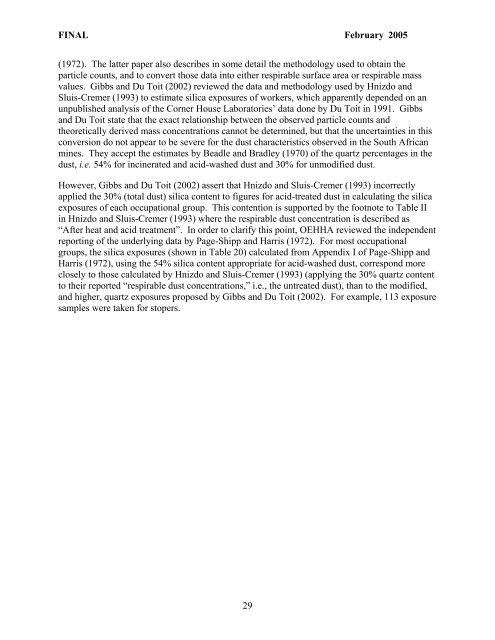Silica (crystalline, respirable) - OEHHA
Silica (crystalline, respirable) - OEHHA
Silica (crystalline, respirable) - OEHHA
Create successful ePaper yourself
Turn your PDF publications into a flip-book with our unique Google optimized e-Paper software.
FINAL February 2005<br />
(1972). The latter paper also describes in some detail the methodology used to obtain the<br />
particle counts, and to convert those data into either <strong>respirable</strong> surface area or <strong>respirable</strong> mass<br />
values. Gibbs and Du Toit (2002) reviewed the data and methodology used by Hnizdo and<br />
Sluis-Cremer (1993) to estimate silica exposures of workers, which apparently depended on an<br />
unpublished analysis of the Corner House Laboratories’ data done by Du Toit in 1991. Gibbs<br />
and Du Toit state that the exact relationship between the observed particle counts and<br />
theoretically derived mass concentrations cannot be determined, but that the uncertainties in this<br />
conversion do not appear to be severe for the dust characteristics observed in the South African<br />
mines. They accept the estimates by Beadle and Bradley (1970) of the quartz percentages in the<br />
dust, i.e. 54% for incinerated and acid-washed dust and 30% for unmodified dust.<br />
However, Gibbs and Du Toit (2002) assert that Hnizdo and Sluis-Cremer (1993) incorrectly<br />
applied the 30% (total dust) silica content to figures for acid-treated dust in calculating the silica<br />
exposures of each occupational group. This contention is supported by the footnote to Table II<br />
in Hnizdo and Sluis-Cremer (1993) where the <strong>respirable</strong> dust concentration is described as<br />
“After heat and acid treatment”. In order to clarify this point, <strong>OEHHA</strong> reviewed the independent<br />
reporting of the underlying data by Page-Shipp and Harris (1972). For most occupational<br />
groups, the silica exposures (shown in Table 20) calculated from Appendix I of Page-Shipp and<br />
Harris (1972), using the 54% silica content appropriate for acid-washed dust, correspond more<br />
closely to those calculated by Hnizdo and Sluis-Cremer (1993) (applying the 30% quartz content<br />
to their reported “<strong>respirable</strong> dust concentrations,” i.e., the untreated dust), than to the modified,<br />
and higher, quartz exposures proposed by Gibbs and Du Toit (2002). For example, 113 exposure<br />
samples were taken for stopers.<br />
29















